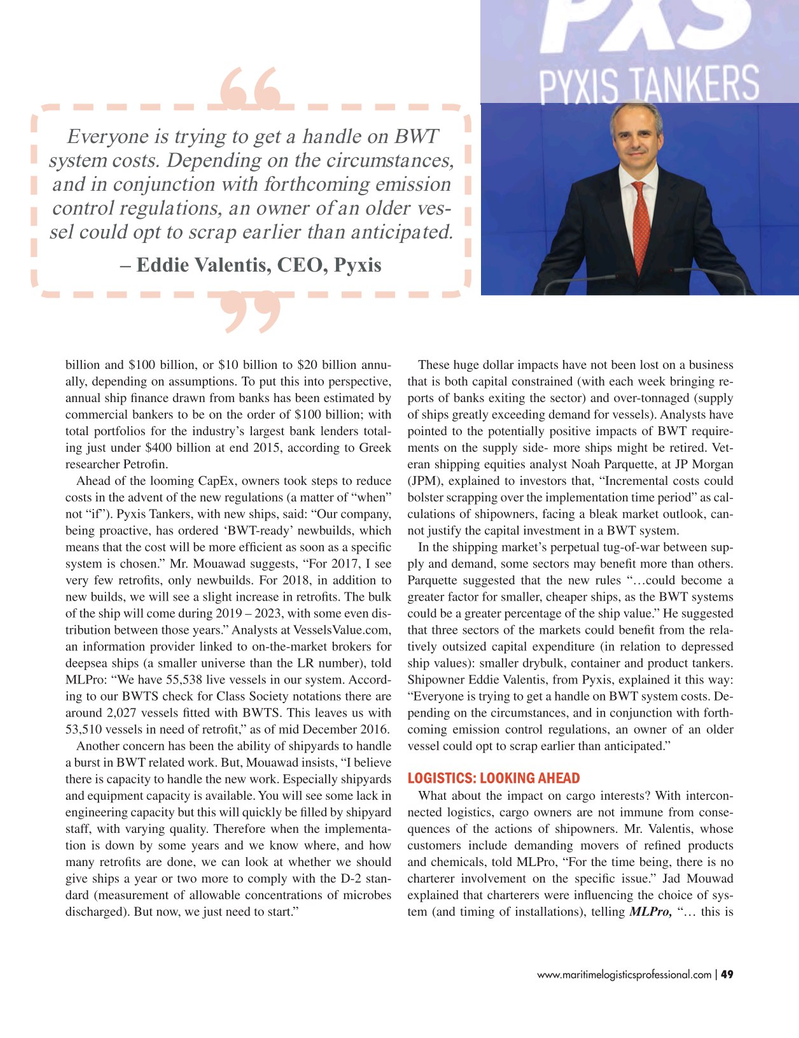
Page 49: of Maritime Logistics Professional Magazine (Mar/Apr 2017)
IT & SOFTWARE
Read this page in Pdf, Flash or Html5 edition of Mar/Apr 2017 Maritime Logistics Professional Magazine
Everyone is trying to get a handle on BWT system costs. Depending on the circumstances, and in conjunction with forthcoming emission control regulations, an owner of an older ves- sel could opt to scrap earlier than anticipated.
– Eddie Valentis, CEO, Pyxis billion and $100 billion, or $10 billion to $20 billion annu- These huge dollar impacts have not been lost on a business ally, depending on assumptions. To put this into perspective, that is both capital constrained (with each week bringing re- annual ship ? nance drawn from banks has been estimated by ports of banks exiting the sector) and over-tonnaged (supply commercial bankers to be on the order of $100 billion; with of ships greatly exceeding demand for vessels). Analysts have total portfolios for the industry’s largest bank lenders total- pointed to the potentially positive impacts of BWT require- ing just under $400 billion at end 2015, according to Greek ments on the supply side- more ships might be retired. Vet- researcher Petro? n. eran shipping equities analyst Noah Parquette, at JP Morgan
Ahead of the looming CapEx, owners took steps to reduce (JPM), explained to investors that, “Incremental costs could costs in the advent of the new regulations (a matter of “when” bolster scrapping over the implementation time period” as cal- not “if”). Pyxis Tankers, with new ships, said: “Our company, culations of shipowners, facing a bleak market outlook, can- being proactive, has ordered ‘BWT-ready’ newbuilds, which not justify the capital investment in a BWT system. means that the cost will be more ef? cient as soon as a speci? c In the shipping market’s perpetual tug-of-war between sup- system is chosen.” Mr. Mouawad suggests, “For 2017, I see ply and demand, some sectors may bene? t more than others. very few retro? ts, only newbuilds. For 2018, in addition to Parquette suggested that the new rules “…could become a new builds, we will see a slight increase in retro? ts. The bulk greater factor for smaller, cheaper ships, as the BWT systems of the ship will come during 2019 – 2023, with some even dis- could be a greater percentage of the ship value.” He suggested tribution between those years.” Analysts at VesselsValue.com, that three sectors of the markets could bene? t from the rela- an information provider linked to on-the-market brokers for tively outsized capital expenditure (in relation to depressed deepsea ships (a smaller universe than the LR number), told ship values): smaller drybulk, container and product tankers.
MLPro: “We have 55,538 live vessels in our system. Accord- Shipowner Eddie Valentis, from Pyxis, explained it this way: ing to our BWTS check for Class Society notations there are “Everyone is trying to get a handle on BWT system costs. De- around 2,027 vessels ? tted with BWTS. This leaves us with pending on the circumstances, and in conjunction with forth- 53,510 vessels in need of retro? t,” as of mid December 2016. coming emission control regulations, an owner of an older
Another concern has been the ability of shipyards to handle vessel could opt to scrap earlier than anticipated.” a burst in BWT related work. But, Mouawad insists, “I believe there is capacity to handle the new work. Especially shipyards LOGISTICS: LOOKING AHEAD and equipment capacity is available. You will see some lack in What about the impact on cargo interests? With intercon- engineering capacity but this will quickly be ? lled by shipyard nected logistics, cargo owners are not immune from conse- staff, with varying quality. Therefore when the implementa- quences of the actions of shipowners. Mr. Valentis, whose tion is down by some years and we know where, and how customers include demanding movers of re? ned products many retro? ts are done, we can look at whether we should and chemicals, told MLPro, “For the time being, there is no give ships a year or two more to comply with the D-2 stan- charterer involvement on the speci? c issue.” Jad Mouwad dard (measurement of allowable concentrations of microbes explained that charterers were in? uencing the choice of sys- discharged). But now, we just need to start.” tem (and timing of installations), telling MLPro, “… this is www.maritimelogisticsprofessional.com 49
I

 48
48

 50
50
